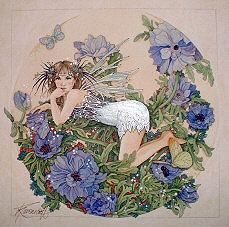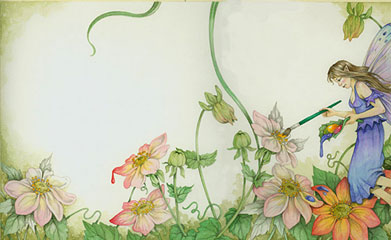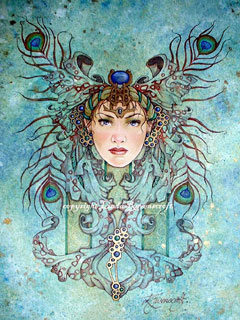Comfort Touch:
Nurturing Acupressure Massage for the Elderly and the Ill
By Mary Kathleen Rose
Originally published in Massage & Bodywork magazine, December/January 2004. Copyright 2003. Associated Bodywork and Massage Professionals. All rights reserved.
"The tiger is ready to go. That was grrrreat!" These are words spoken by an 82-year-old man who had recently been released after a month in the hospital.  He had just received his first session of Comfort Touch. Peg, the massage therapist who relayed his story to me, had recently attended my workshop "Comfort Touch for the Elderly and the Ill."
He had just received his first session of Comfort Touch. Peg, the massage therapist who relayed his story to me, had recently attended my workshop "Comfort Touch for the Elderly and the Ill."
Another therapist, Kathleen, shared her experience of using Comfort Touch in a hospital: "It is incredible. You look in the eyes of the patient, knowing you made a difference."
For more than 12 years now, I have listened to the stories of both the givers and the receivers of Comfort Touch. I am grateful for the many massage therapists and other healthcare providers who have been participants in my classes and contributed to the understanding of this work as I developed it. All have been a part of this journey of discovery about massage with the elderly and the ill.
The Beginning
My story began in 1984. I was a student at the Boulder School of Massage Therapy, and I had decided to practice massage in a skilled nursing facility for my fieldwork placement. Over a period of 10 weeks I had the opportunity to offer massage to many of the residents. They represented a range of ages, physical conditions and emotional states of being. I remember bracing myself for the experience as I walked in the door of the building for the first time, not knowing what to expect, unsure of how I would touch the people I met.
In school I worked with other healthy, and relatively young, people like myself. Now I was confronted with individuals who were in wheelchairs or hospital beds. Some could speak and communicate their needs. Others could not. Some could get around with the help of walkers, others were bedridden, or recovering from strokes or major surgeries. I remember the looks of pain, sadness and loneliness. I remember the ramblings of those suffering with dementia. I remember the sweet smiles of those who were simply grateful that someone looked at them and noticed they were alive. They had no idea what to expect from me. The administration and staff were also unsure if massage would be useful.
And so I began with the notion that they could benefit by being touched. Isn't this a basic human need, as essential as food, water and shelter? An inner compulsion guided me as I met the patients, and I trusted my intuition to let me know how to touch them safely and appropriately.
Hospice
In 1989, I began to volunteer to give massage to patients of our local hospice, an organization that provides comprehensive, compassionate end-of-life care. Again, as with the residents of the nursing home and clients in my private practice, I found myself responding to the needs of these patients, often with little idea of what approach I would take. There are considerations about the physiological conditions of the elder populations, and/or those living with chronic disease, that require significant adjustments in technique to ensure the massage is both safe and appropriate.
Unlike the work for which most massage therapists are trained, I was working with those who were bedridden or had limited mobility. So I worked with them in their beds at home or in hospital beds if they were in a facility. To be effective in offering touch, as well as to prevent injury or discomfort to my own body, I had to learn how to adjust my core mechanics.
I also developed a greater understanding of the importance of non-verbal communication and how to respond not only to the physiological needs of the client, but to respect the emotional and psychological processes that people are experiencing as they deal with life-threatening illness. Most people who are active in this field also acknowledge the personal work they must do to stay clear in their own boundaries. While offering compassionate care, it is important to take care of one's own emotional being.
Beginning in 1991, the staff of HospiceCare of Boulder and Broomfield counties asked me to teach others what I knew about massage in this context. I had spoken with other massage therapists who had offered massage to hospice patients over the years. Our local hospice had been a pioneer in the use of massage and, coupled with graduates of the Boulder School of Massage Therapy, had initiated a program in the late 1970s. But there had been no real supervision or training. Now, as more massage therapists indicated interested in the program, it became obvious that it would be valuable to establish some guidelines and offer specific training. Since that time, I have trained hundreds of massage therapists, as well as other healthcare professionals (from the fields of nursing and physical and occupational therapy) and hospice volunteers in the style of massage that is referred to as Comfort Touch.
Comfort Touch
So what is Comfort Touch and how can it be distinguished from other forms of massage and bodywork?
- Safety concerns and the condition of the client: Comfort Touch is a form of bodywork designed to be safe and appropriate for a broad range of people, for whom other styles of massage would be contraindicated. For example, in the elderly the skin can be very fragile and Swedish massage strokes of effleurage or petrissage can actually tear the skin or cause bruising of the blood vessels.
- The setting of the massage: Comfort Touch can be practiced anywhere. No special equipment is required. The client can be fully clothed in a chair, recliner or on a bed of any height.
- Body mechanics for the giver of touch: The therapist must adjust to the client by adapting her body mechanics to maximize effectiveness of the contact and ensure safety. During the training, stools, chairs or cushions are used by therapists as they work. Practitioners must be comfortable in their own bodies to offer comfort, and in some situations will need to limit what they do in order to respect their own bodies.
- The positioning of the client: Comfort Touch is usually performed with the client in the supine position. The prone position is contraindicated due to the limited mobility of the client, as well as concerns about breathing. It is also difficult to communicate with a client in the prone position. Techniques are adapted to be performed in the supine position, as well as the seated or side-lying positions. Pillows and towels are used liberally to position the client comfortably.
It is also difficult to communicate with a client in the prone position. Techniques are adapted to be performed in the supine position, as well as the seated or side-lying positions. Pillows and towels are used liberally to position the client comfortably.
- Specific techniques of Comfort Touch: The techniques of Comfort Touch are largely derived from Asian bodywork (shiatsu and acupressure), which gives great adaptability and flexibility to the work. It incorporates an understanding of the energetic qualities of the meridian system of the body, as well as major motor points of the muscles.
- Principles and intentions of Comfort Touch: This work is characterized by the intention to offer comfort. Other general principles that govern the work are described below.
The Principles of Comfort Touch
There are six principles that guide the practitioner of Comfort Touch. An easy way to remember them is to use the acronym "scribe," which relays the intention and quality of touch used in this work. Comfort Touch is:
- Slow -- Relax and be present in the moment, letting your own breath be full and deep. Moving slowly creates a restful atmosphere and allows for a safe and appropriate experience for both the giver and receiver of touch.
- Comforting -- Make the person comfortable and offer a soothing, nurturing touch. Your intention is to ease pain, not to try to cure or fix the person. The word "comfort" literally means "with strength." To give comfort one must come from a place of inner personal strength and share that strength and support with the person who needs it. To comfort also means to acknowledge the individual's inner strength and resources.
 - Respectful -- Always maintain a respectful attitude toward your clients, appreciating the vulnerability they may feel about being touched. Listen to what they tell you, verbally and non-verbally. Be sensitive to their feedback about your touch. A respectful attitude that is compassionate and non-judgmental contributes to a safe and healing atmosphere for the client.
- Respectful -- Always maintain a respectful attitude toward your clients, appreciating the vulnerability they may feel about being touched. Listen to what they tell you, verbally and non-verbally. Be sensitive to their feedback about your touch. A respectful attitude that is compassionate and non-judgmental contributes to a safe and healing atmosphere for the client.
- Into Center -- The direction of pressure in Comfort Touch is in to the center of the particular part of the body you are touching. Pressure is applied perpendicularly to the skin, thereby preventing tearing of the skin or bruising of the tissues. The focus of intention is into the core or central axis of the part of the body being touched. This specific direction of pressure and accurate focusing inward of intention allow for a penetrating touch, even with light to moderate pressure. Both the giver and receiver of touch experience a profoundly deep sense of connection.
- Broad -- In general, all strokes are applied with a broad even pressure. This contributes to a feeling of soothing comfort and connection. While the pressure may be firm, the broadness of contact prevents the likelihood of injury or discomfort. Let the entire surface of your hand, especially including your palm, make uniformly even contact with the part of the client's body you are touching. Imagine your hand is melting into the person's body.
- Encompassing -- Let your touch surround
the person's body. Be aware of the relationship between your
two hands and the energetic field that exists between them.
Hold the person in this space. When touching a large area,
such as the back, acknowledge the shapes and contours of the
body. When touching a limb or a toe, for example, encompass
and enfold that part of the body. Encompassing touch contributes
to a feeling of wholeness, of being cared for and acknowledged
as a worthwhile human being.
Resources
Rose, Mary Kathleen. The Gift of Touch -- Comfort Touch: Massage
for the Elderly and the Chronically and Terminally Ill. Hospice
of Boulder County, 1996.
 Mary
Kathleen Rose, CMT, has more than 25 years experience in the
holistic health field. She supervises the massage therapy
program at HospiceCare of Boulder and Broomfield counties
in Colorado, and offers trainings in Comfort Touch in various
massage schools and medical settings. She can be reached at
303/449-3945 or rosevine@comforttouch.com.
Mary
Kathleen Rose, CMT, has more than 25 years experience in the
holistic health field. She supervises the massage therapy
program at HospiceCare of Boulder and Broomfield counties
in Colorado, and offers trainings in Comfort Touch in various
massage schools and medical settings. She can be reached at
303/449-3945 or rosevine@comforttouch.com.

COMFORT TOUCH DVD - NOW AVAILABLE
This beautifully produced video introduces the viewer to the principles and techniques of Comfort Touch, a nurturing form of acupressure massage designed to be safe and appropriate for the elderly and the ill. Drawing on her many years of experience practicing and teaching this work in home-care and medical settings, Mary Kathleen Rose shares the essential elements of Comfort Touch with demonstrations of its applications in the seated, supine and side-lying positions.
This program will inspire the viewer - whether healthcare professional or family caregiver - to offer the benefits of touch to those for whom conventional massage may cause discomfort or even injury. While Comfort Touch provides soothing relief for the elderly and the ill, it can enhance the quality of life for anyone in need of a caring touch.
Includes 40-page Video Guide, complete with Principles and Techniques of Comfort Touch, Benefits of Comfort Touch, Precautions in the Use of Touch and Self-Care Exercises for the Caregiver. Yours for $29.00 plus shipping.







